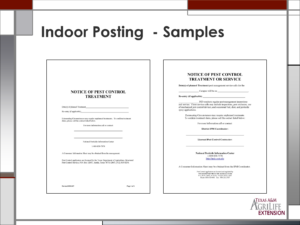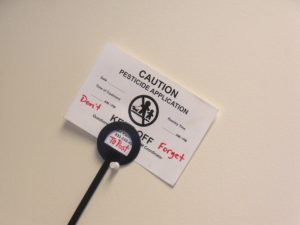
The sign on the left is the standard 48 posting notification that TDA publishes on their website. The sign on the right is something AgriLife Extension developed with TDA for schools to use.
September brings the beginning of a new state fiscal year, where new rules and regulations come into effect throughout our state. TDA/SPCS recently sent out an email to all the leaders of TX Charter Schools informing them that starting this September, they do fall under the school integrated pest management (IPM) laws and regulations. As such, they will need to follow what we have been doing for the past 30 years in Independent School Districts, which includes training, recordkeeping, appointment of an IPM Coordinator, and much more as many of you know. Division 7 of the Texas Administrative Code “INTEGRATED PEST MANAGEMENT PROGRAM FOR SCHOOL DISTRICTS” is the section of the rules that gives guidance to how we train for school IPM, how districts should implement their school IPM programs and what it takes to be in compliance with the rules.
Texas law requires all public-school districts to adopt an IPM program and to designate an IPM Coordinator to manage the implementation of the IPM program. Up until now, only Texas public school districts were required to adhere to IPM in school requirements in statute (1951.212) and regulations. When the law was first adopted in May 1991, Texas Agricultural Extension Service (Texas A&M AgriLife Extension Service since 2019) has been part of the educational process for the development of school IPM coordinator training. Since 2002, the School IPM Website hosts a variety of documents, IPM action plans, and sample policy statements that help all school systems and other sensitive environments with IPM program implementation.
IPM emphasizes the need for proactive and environmentally responsible pest management strategies within our school environments ensuring the safety and health of students and staff in Texas.
The Texas Department of Agriculture Structural Pest Control Service issued a statement when they made their announcement to the Charter schools.
“We understand that this is a significant change and will require time to implement so the department will provide a year to allow open-enrollment charter schools to setup their IPM program. Beginning September 1, 2026, open-enrollment charter school districts must follow IPM rules. TDA will begin inspections of open-enrollment charter school districts after September 1, 2026. All TDA routine school IPM inspections are scheduled and a TDA inspector will contact each charter school district between September 2026 and August 2027 to schedule an inspection.”
Below are additional resources, and training opportunities will be made available to assist you in complying with these new requirements.
The school IPM requirements include:
- All open-enrollment public school charters must adopt an IPM Policy. The IPM Policy requirements are found in 7.201: Responsibilities of School Districts. Texas A&M AgriLife Extension Service School IPM Specialist Janet Hurley can assist with sample IPM policies and TDA has a sample policy on our website found here.
- All open-enrollment public school charters must appoint at least one IPM Coordinator. Additional IPM Coordinators may be appointed; if you choose to have more than one IPM Coordinator, one of the appointed IPM Coordinators must be designated as the Responsible IPM Coordinator. The IPM Coordinator responsibilities can be found in 7.202: Education Requirements a Responsibilities of IPM Coordinator. The SPCS-431: School IPM Coordinator Information form is used to designate an IPM Coordinator and must be submitted within 90 days of designation. Schools may not be without a designated IPM Coordinator for more than 30 days. All IPM Coordinators must attend a School IPM Coordinator Training within six months of being designated IPM Coordinator.
- All pesticide applicators must be licensed to make applications on open-enrollment public school charter grounds. Records of all pesticide applications and pest control work orders must be maintained for two years. More on requirements of licensed applicators can be found in 7.203: Responsibilities of Certified Applicators and Licensed Technicians. Please note, pesticides used to sanitize (like bleach) or used on living-man (like hand sanitizer and lice products) are not included in licensing requirements.
- Posting pesticide applications and restricting students’ access to areas treated with pesticides is required. Additionally, how pesticides are used and how often they can be used is explained in 7.204: Pesticide Use in Schools.
To help guide the first steps, begin by developing your IPM policy and designating an IPM Coordinator. If you have a contracted company providing pest control in and around your buildings, make them aware of this change. If you have licensed pesticide applicators, review 7.203 & 7.204.
Below you will find links to more helpful IPM resources.
- TDA School IPM page
- TDA School IPM Forms
- Texas A&M AgriLife School IPM Page (IPM Coordinator Training Provider)
- Texas A&M AgriLife School IPM Forms
- Texas A&M AgriLife School IPM Sample Pest Management Plans
- National Pesticide Information Center School IPM


 .
.